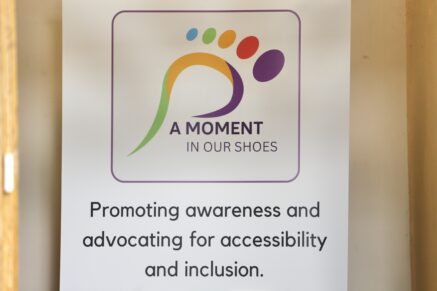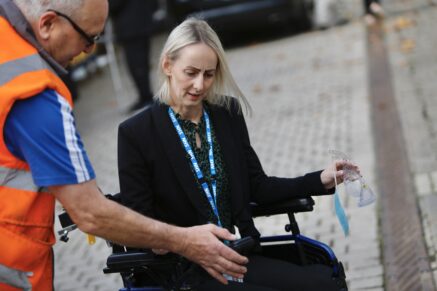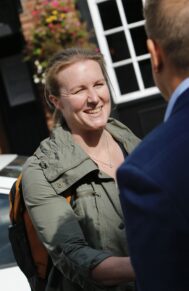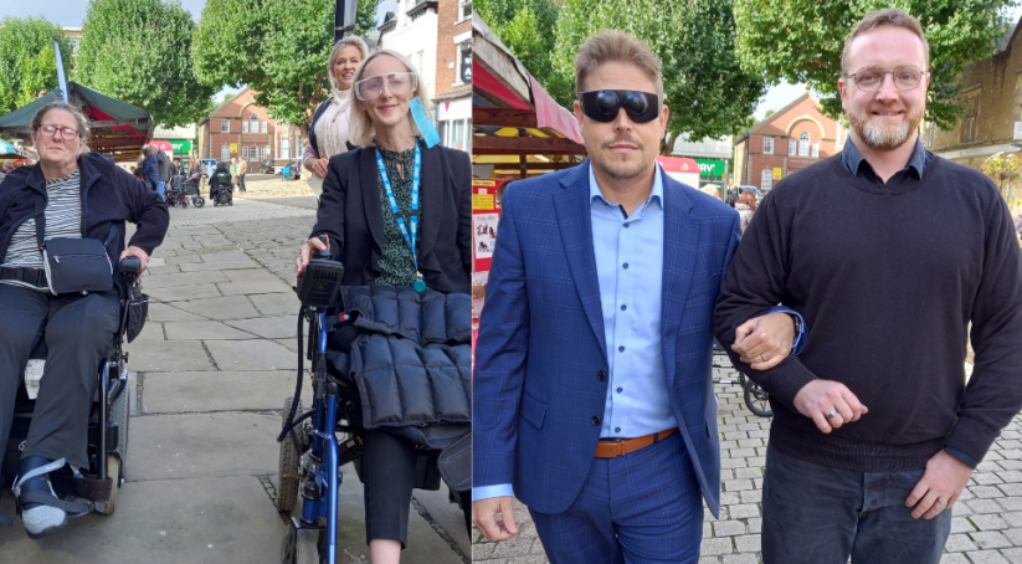We spent a moment in the shoes of people who have disabilities – this is what we learned
Our NHS managers have spent “a moment in our shoes” as part of National Inclusion Week.
The event on Tuesday in Chesterfield town centre brought together a wide range of disability charities and support organisations.
They shared their experiences, celebrated the lives of people who have disabilities and listened to inspirational speakers throughout the day.
Our head of partnerships Kirsty Ball and partnerships manager David Lilley-Brown volunteered to spend “a moment in our shoes”.
Kirsty borrowed a motorised wheelchair and put on a pair of goggles that simulate having cataracts to join Sue Higgins for a tour around the Market Hall and shopping centre – negotiating cobbles, obstructions and the frustration of not being able to reach many items.
David tried a pair of “tunnel vision” goggles designed to simulate partial sight and was guided around the town by Peter North, from the Royal National Institute of Blind People. He also used a pair of goggles designed to simulate the experience of severely sight impaired people.

Sue’s story
Sue Higgins, from Chesterfield, was the inspiration for social prescriber Karen Lawson to organise the “A moment in our shoes” event.
Sue worked for many years in Clark’s shoe shop in Chesterfield until her advancing multiple sclerosis took away the use of her legs and forced her to stop about eight years ago.
Sue said: “When I was able-bodied I used to be able to do things spontaneously. Now everything has to be done in the window of time I have with my carers.
“I am independent. I like to do things myself. I don’t crave attention.
“But people think that because I am in a wheelchair that I want something from them.
“I don’t, but I do want to be able to use the front entrance of a shop, not the back door. I don’t want to knock on the window and be served in the street because I can’t get in.
“It can be so frustrating. I can’t go out on bin day because it’s impossible to get along the pavements.
“If I go to the optician for an eye test my wheelchair has to be virtually dismantled for me to reach the testing machine.
“When I use NHS services it can be hard. I had to be taken to hospital recently in an emergency ambulance.
“They couldn’t take my wheelchair in the ambulance, so I had to be transferred onto a stretcher. Then when I arrived I had to move from the ambulance stretcher to an A&E stretcher, then to a ward stretcher and then finally to a chair.
“When I discharged myself the next day I was so grateful to be back in my own wheelchair. It had been so uncomfortable.
“I just want people to give a little more understanding and thought towards people who cannot do everyday things. I just want to be treated as a normal person.”

Kirsty’s story
Kirsty Ball, head of partnerships for NHS Derby and Derbyshire, works in her job with community-based organisations to provide health and care services.
She said: “I know Chesterfield well, but getting around in a wheelchair made me see the town in a different way.
“I was worried about some of the gaps between the cobbles and in some shops the floor sloped quite a lot and it felt like I was going downhill.
“I wouldn’t have wanted to do that if I was in a rush.
“The goggles I was wearing made it difficult to see people’s faces, so you don’t make that eye contact with people and that becomes quite isolating.
“My thoughts afterwards are that it makes me more determined that we should commission services in a way that they are accessible for everybody.
“It is the detail that needs thinking through. For example, Sue’s chair was taken away for servicing for several hours, but she wasn’t provided with a replacement while the work was done. So that meant she couldn’t move during that time.
“We need to understand the detail of the needs of people who have disabilities.”

Claire’s story
Claire North, regional campaigns officer for the Royal National Institution of Blind People, lost her sight gradually in her late teens and early 20s and is now severely sight impaired. She is supported to get around by her support worker Peter North.
Peter guided partnerships manager David Lilley-Brown on a walk around the Market Hall in Chesterfield before leading him through the Grace’s Chapel, which was busy with people, noise, chairs, tables and display stands.
David wore two different types of simulation glasses for his walk: one type that simulated tunnel vision and the other that simulated partial vision where the wearer can sense light and dark, but no shapes.
Claire said: “A person with tunnel vision can see very little around them, but you can see things that are close. So they may be able to read text on a mobile phone, for example, and people think: ‘They are not blind,’ but they are still partially sighted.
“I am supported by Peter to get around, but I’m used to bumping into things. We bounce.
“It can be incredibly intimidating to go into a busy environment, especially somewhere like a hospital. I gave birth not long ago and all those bright lights are very hard.
“It can be really scary. Until you have stepped into someone’s shoes you don’t know what it is like.
“As the RNIB we are campaigning for people who work in the NHS to use the accessible information standard, which means that people should receive information in a format that is appropriate for them.
“We are also campaigning to make it a legal right for people to be seen within six months for rehabilitation after a diagnosis of sight loss.
“Can you imagine if you are a driver, you lose your sight and your keys are taken from you? You have lost a big part of what you are. You need rehabilitation and you need emotional support too.”

David’s story
David said: “My grandad got glaucoma and started going blind at roughly the age I am now, so in a strange way today’s event has brought me a little closer to him as it has helped me to better understand what that must have felt like for him. It has been quite emotional for me.
“He was aware of the light, but he couldn’t see more than that, so the goggles I wore were a bit like that. It is like a very thick fog.
“Wearing the tunnel vision goggles was an experience too. You don’t realise how much you see normally. As you walk you can hear the sounds of people and cars but you can’t see them.
“I felt like I might be able to adapt to that, but when I walked inside with the fog glasses on, that was much harder. I felt like I was going to walk into something.
“I was aware of becoming quite vulnerable in a short space of time. One moment you can see and the next you can’t.
“I like to look at people in order to engage them and suddenly I couldn’t do that.
“Today has shown me that there is more to do in society to make day-to-day activities such as shopping and visiting your GP more accessible and easier for everyone.
“Stepping into the shoes of those who have disabilities is something I would encourage others to do because you can never truly understand the daily challenges they are presented with otherwise.”


